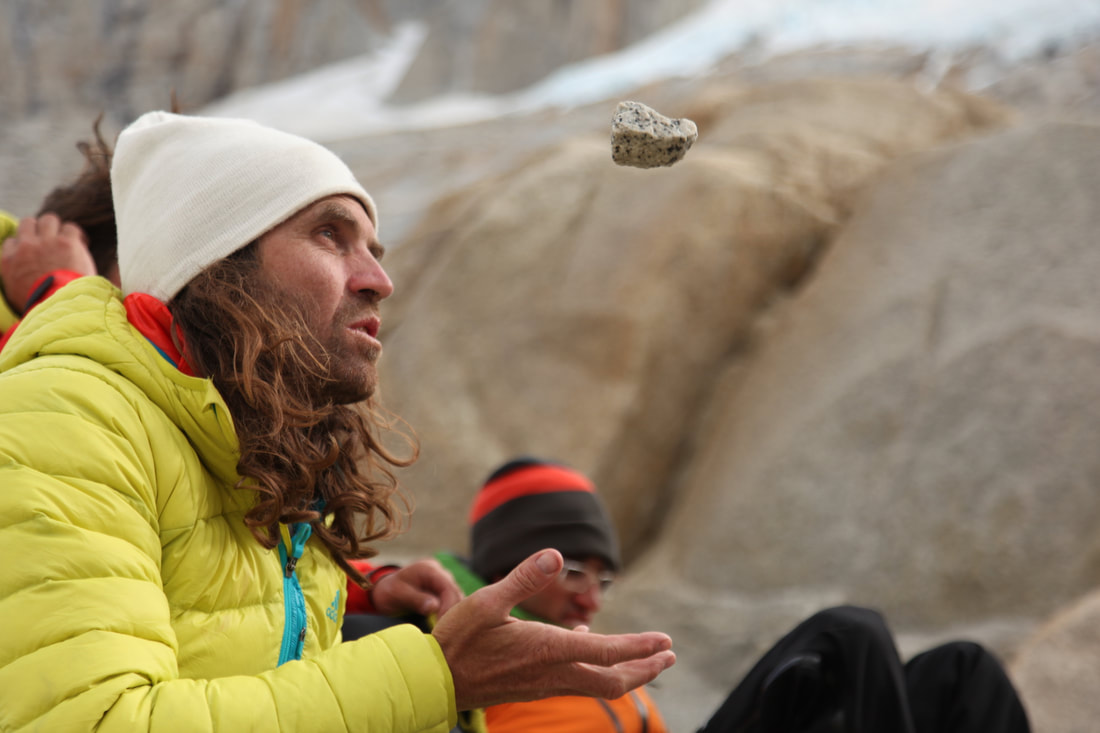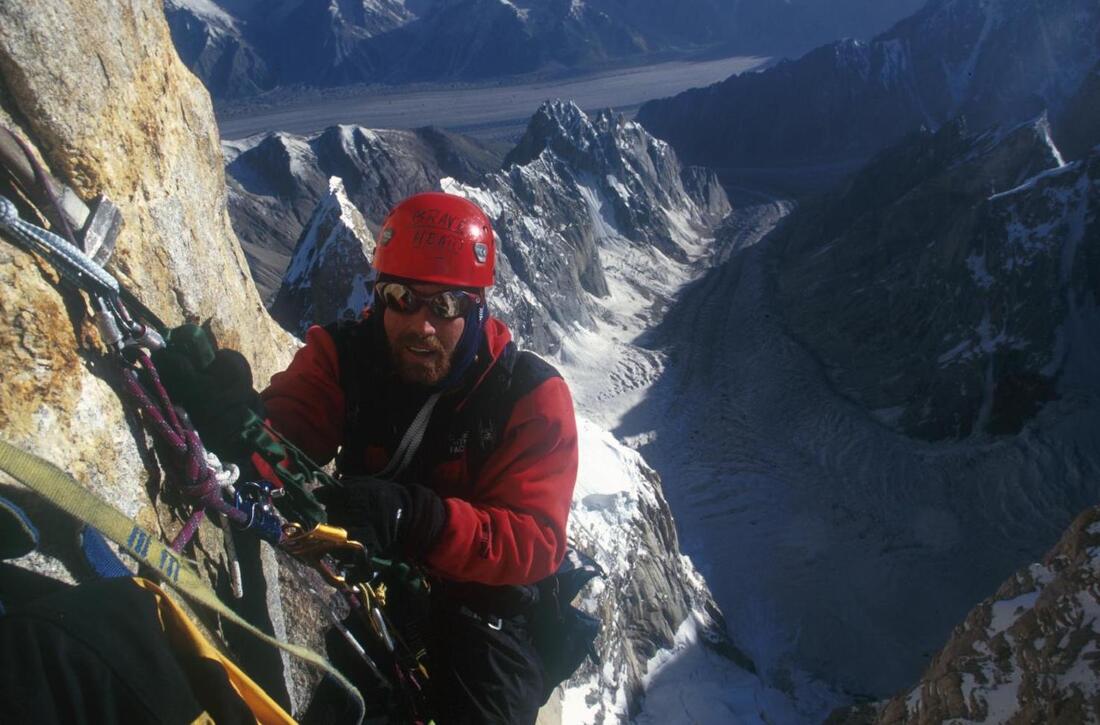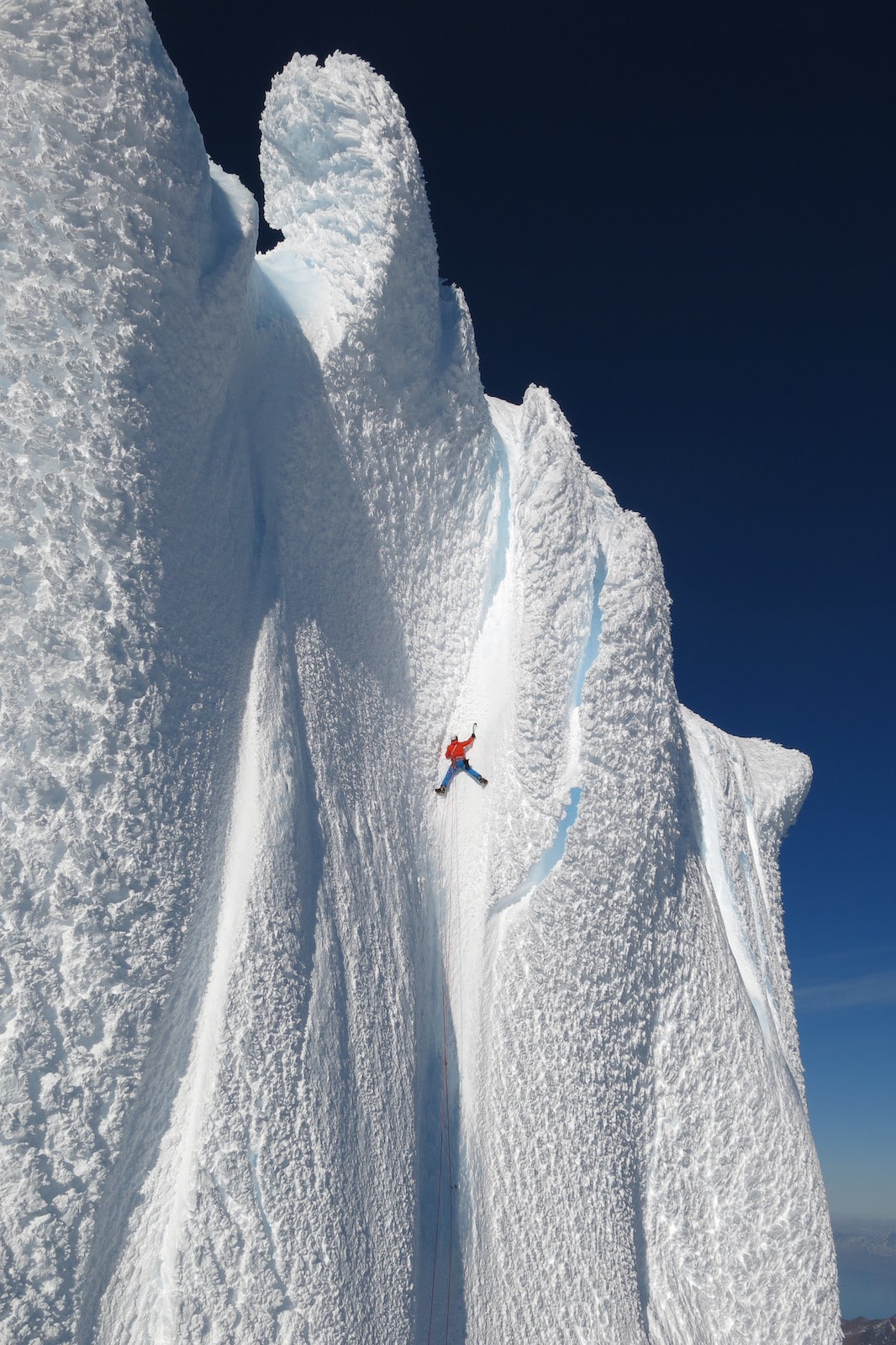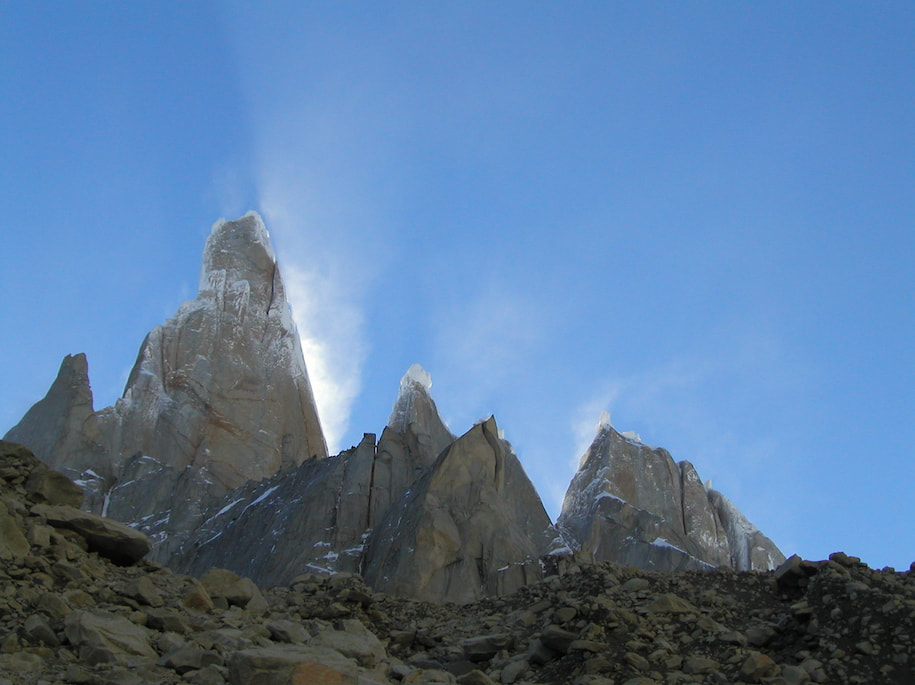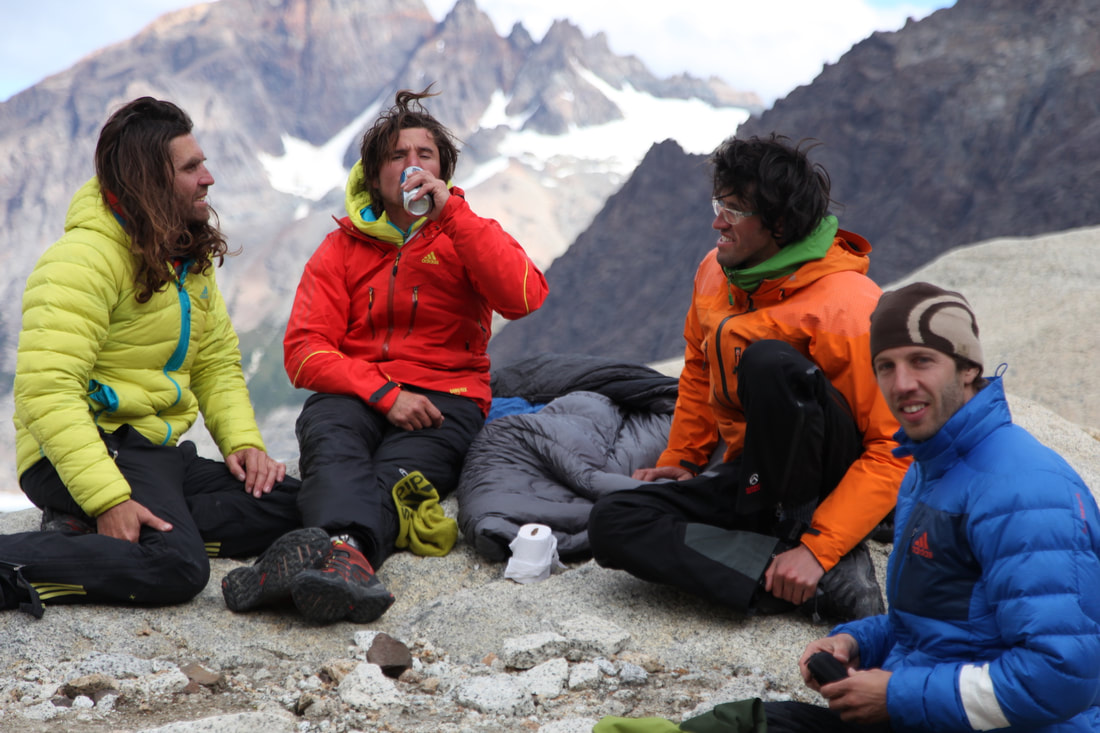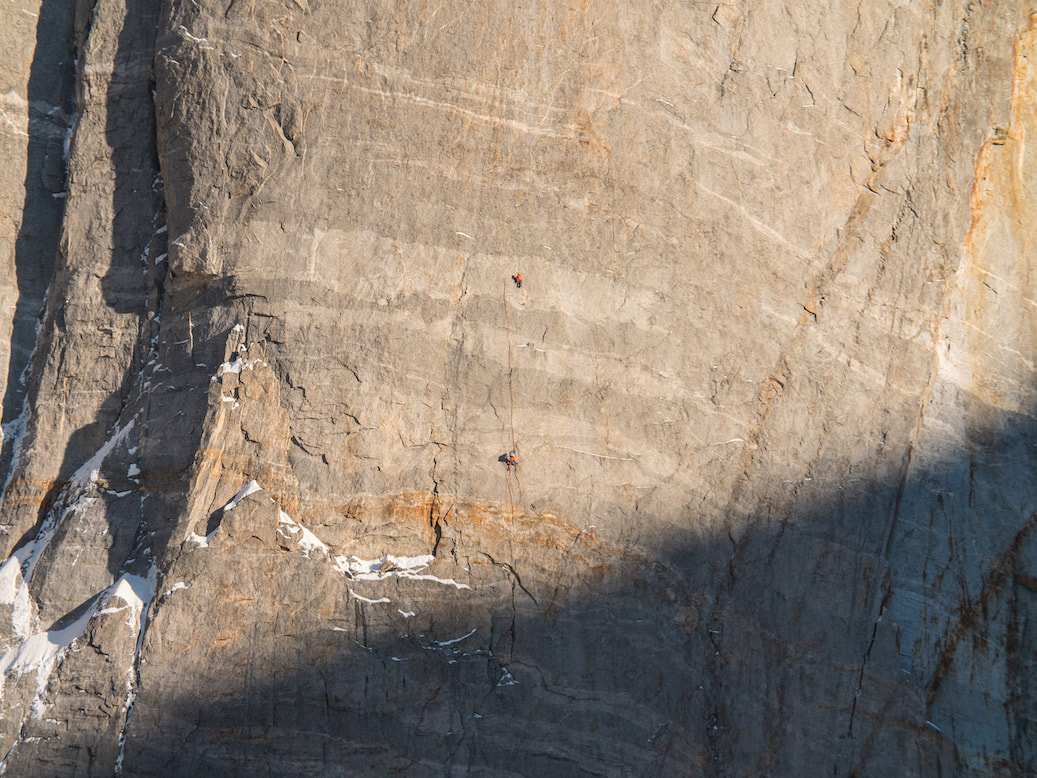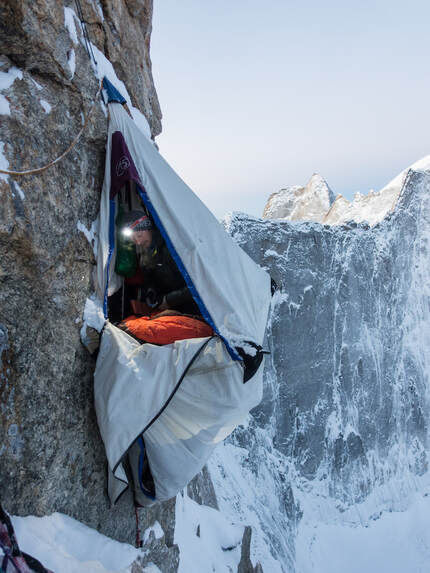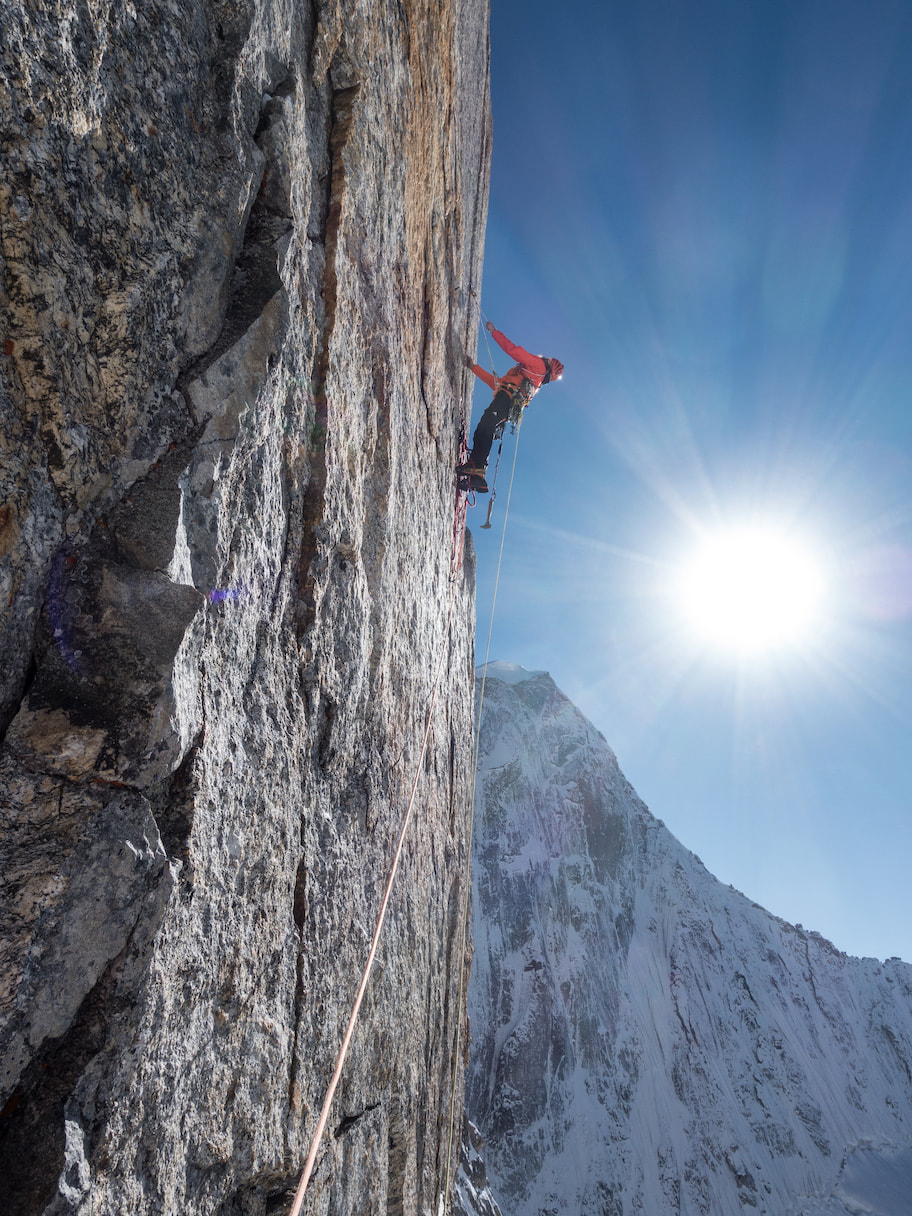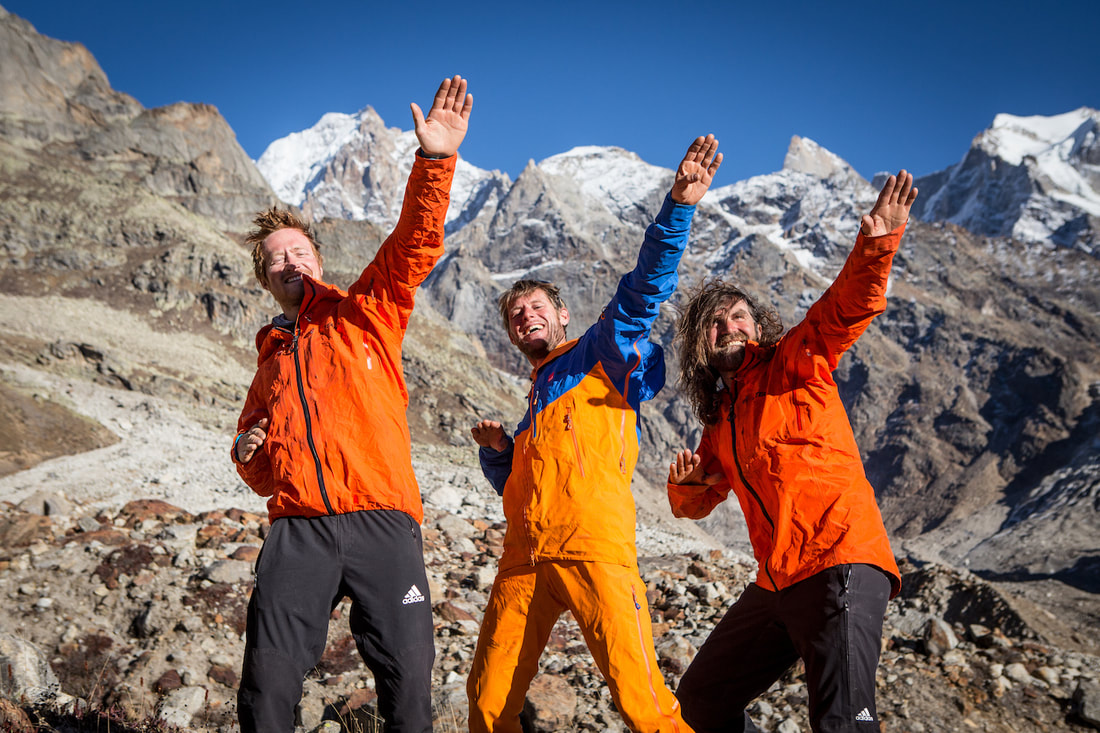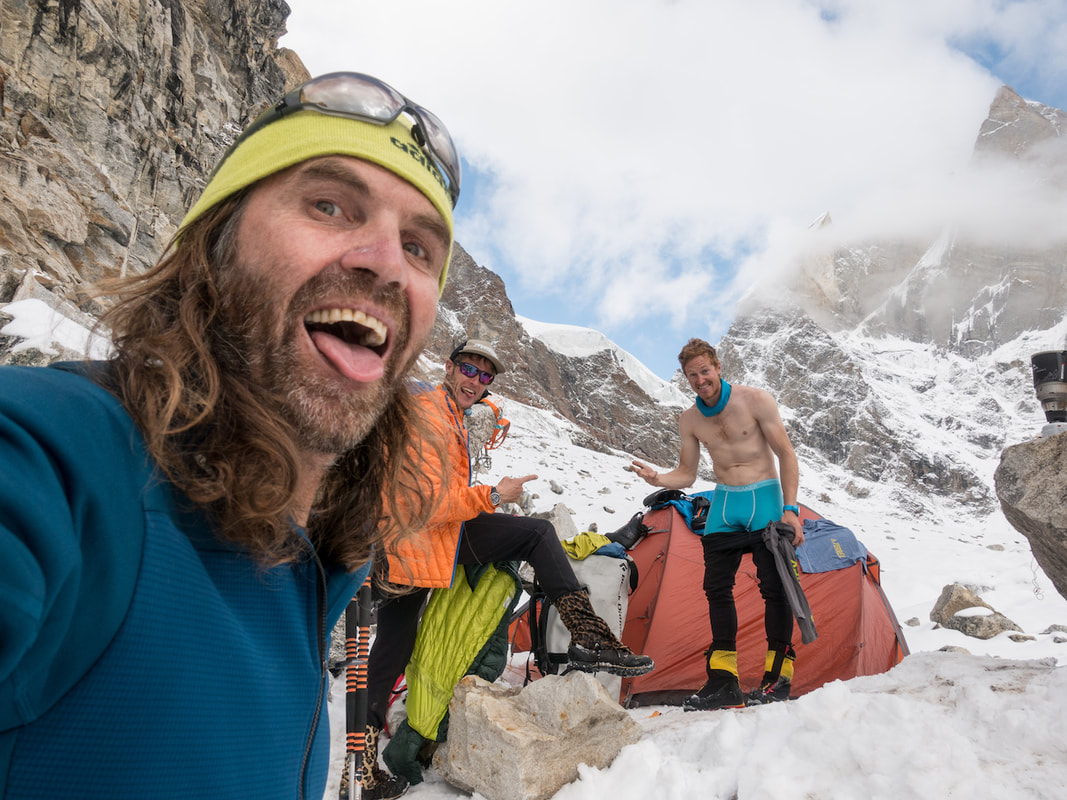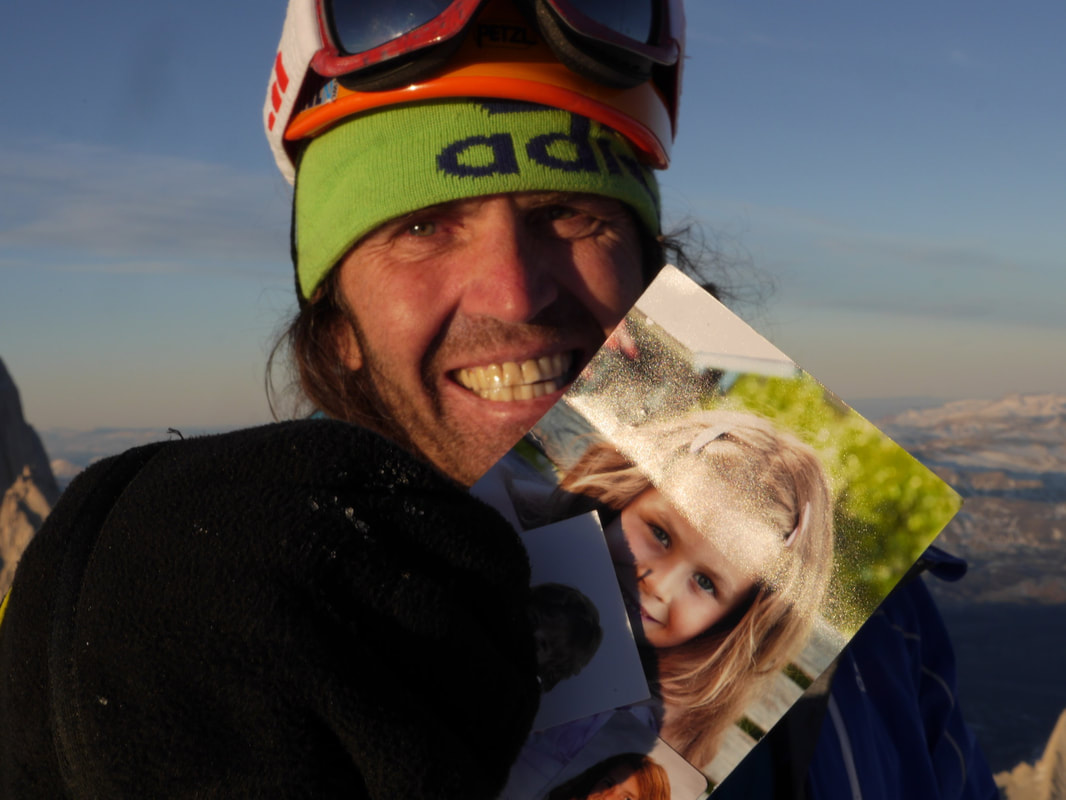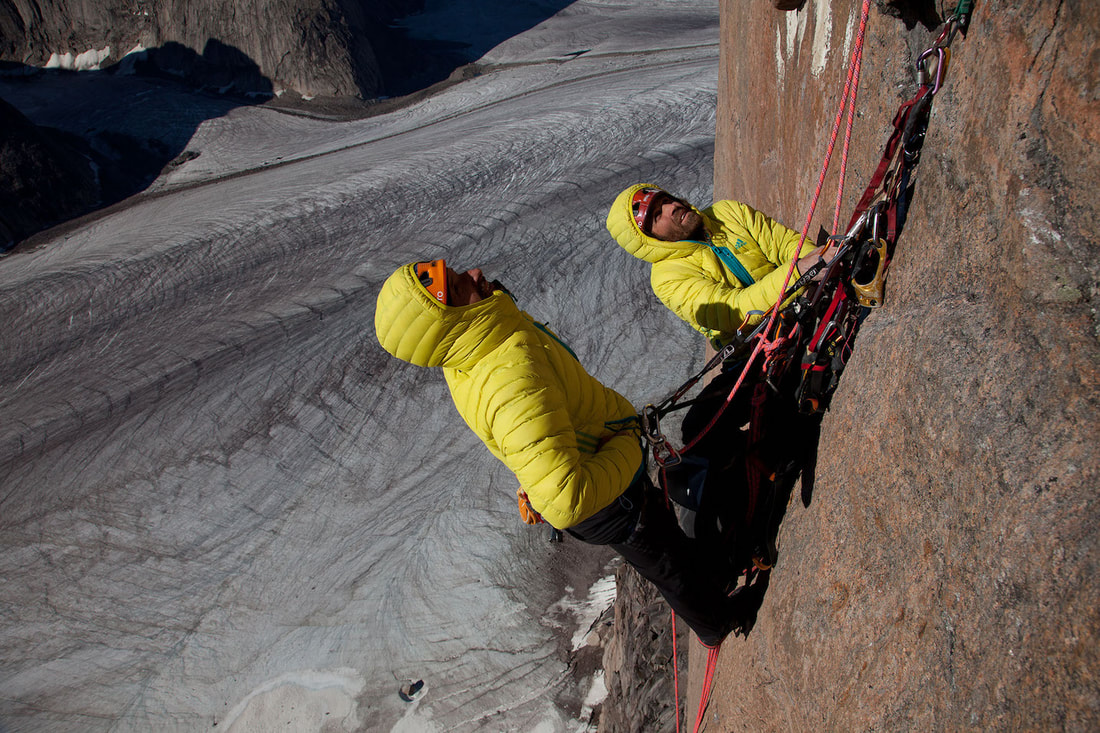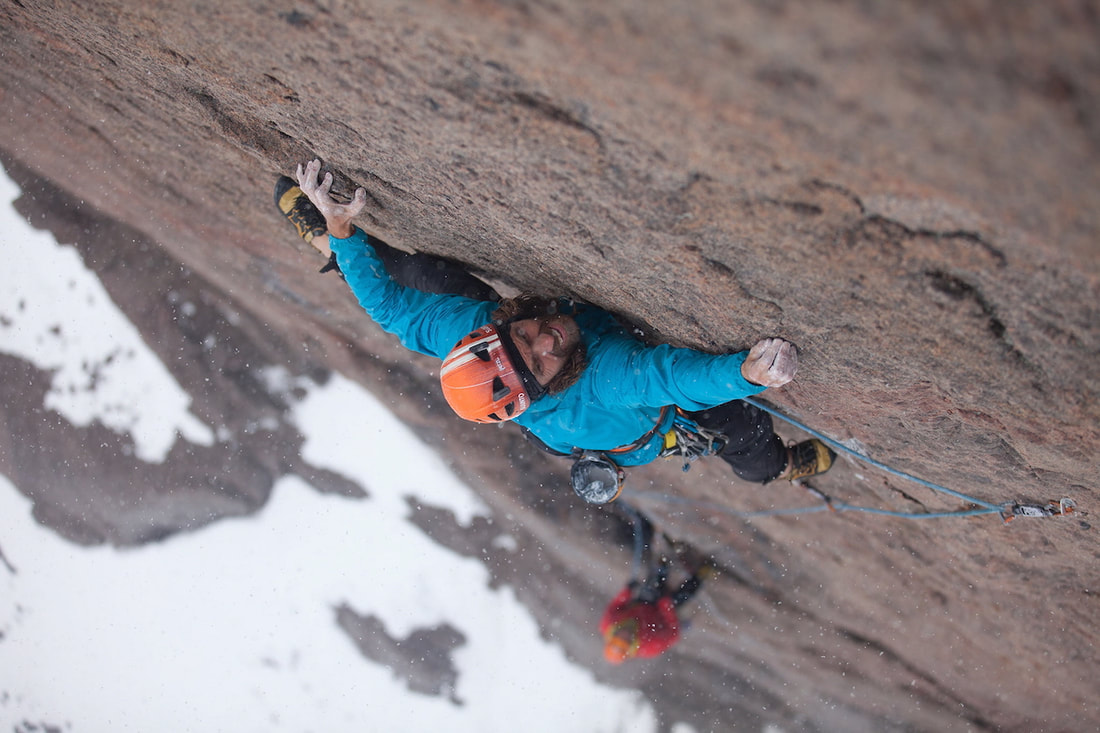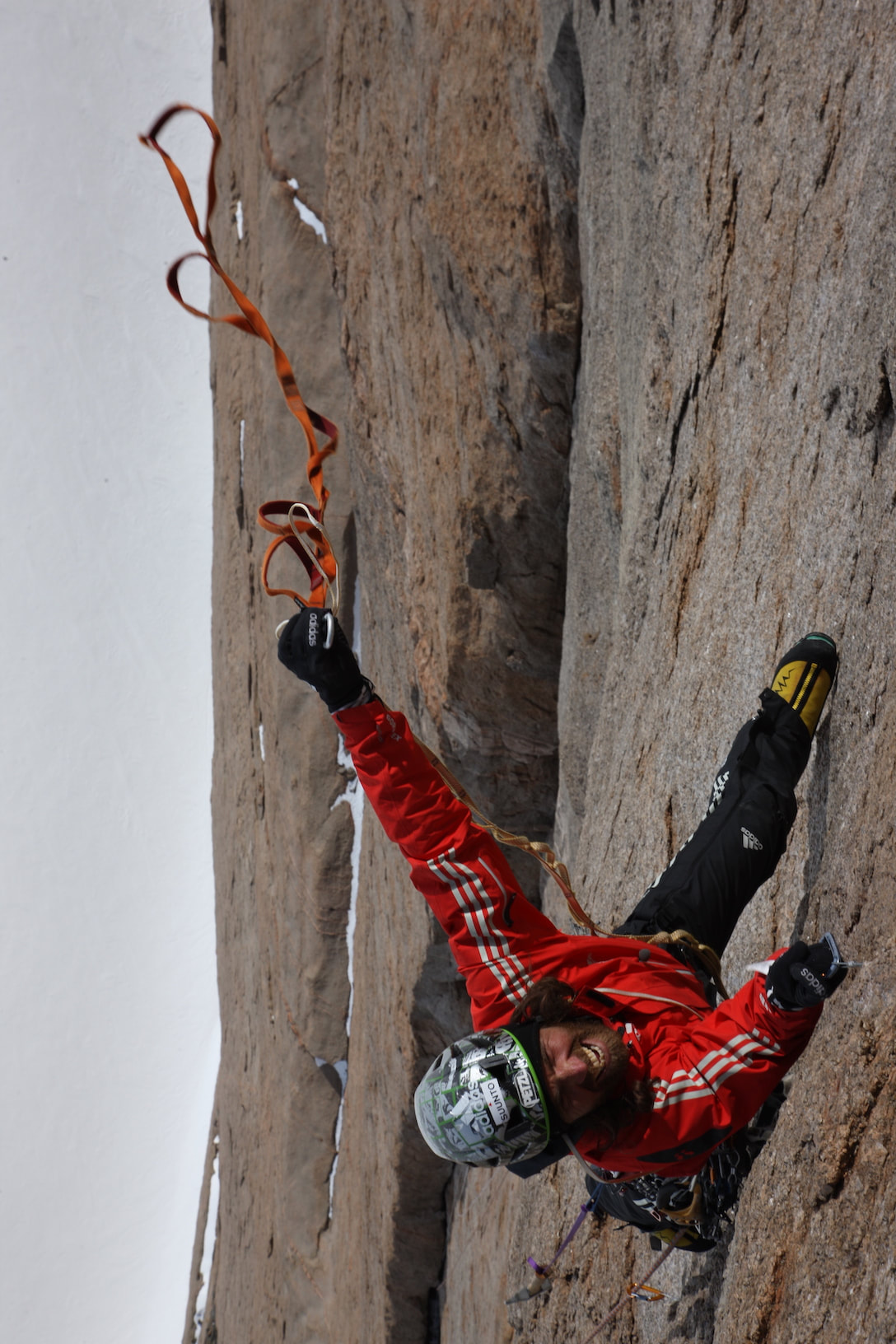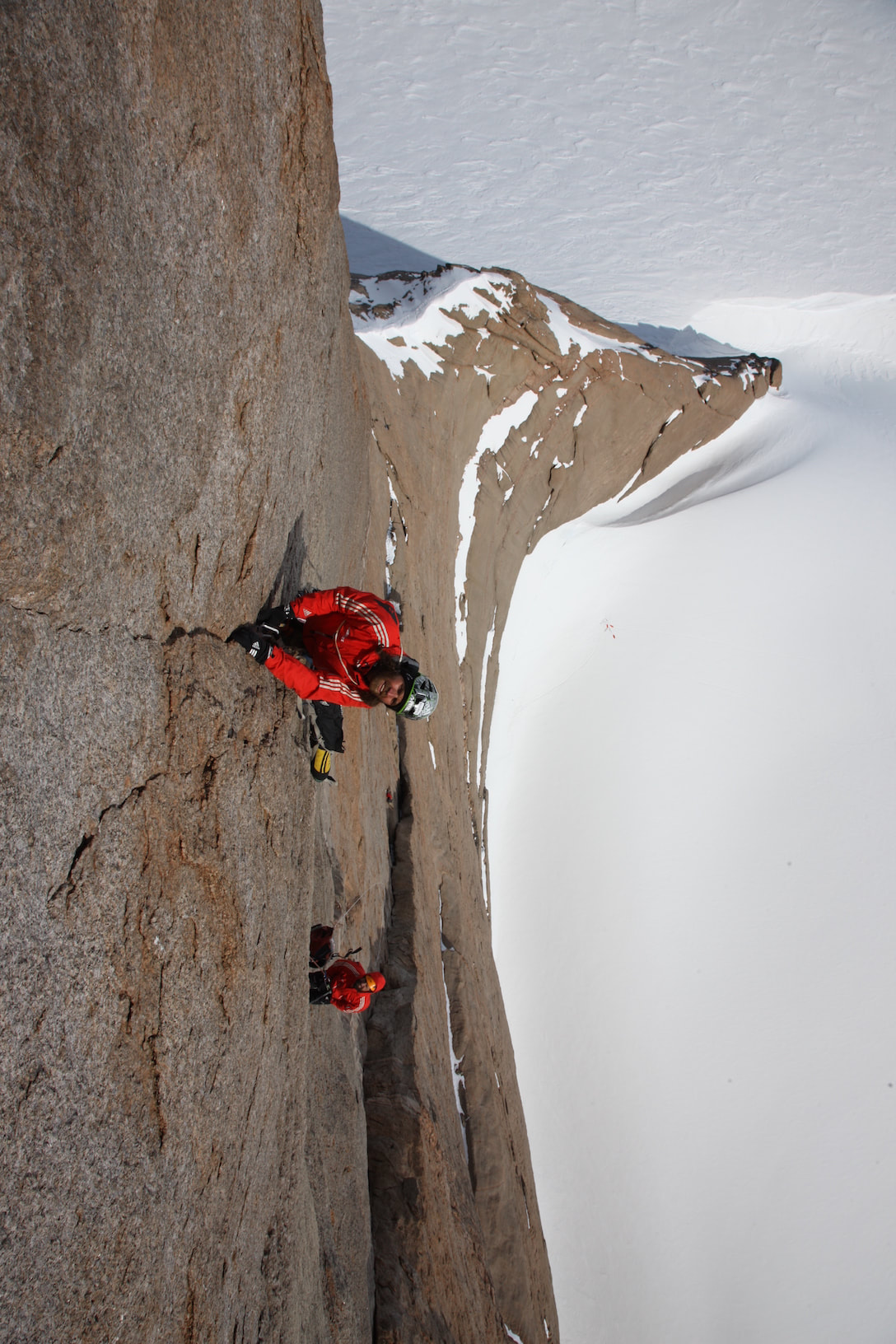ED: Thomas Huber is a German rock climber and mountaineer with an esteemed career. Thomas and his brother Alexander, known as the “Huberbaum” (Huber boys), are known for their joint first ascents on El Capitan in Yosemite (Free Rider and Salathe Wall to name a couple, as well as, record-setting speed ascents of The Nose), and numerous first ascents on big peaks in Pakistan and Antarctica. In this incredible piece, Thomas takes us on a climbing journey, reflecting upon some of his personally noteworthy accomplishments, what drives him as a mountaineer, and what motivated some of his chosen paths. We hope you enjoy this tale from a man whose “fascination is to make the impossible possible.” [This is an English adaptation of the story re-published with permission from Klettern Magazine (Germany)]
AND SO IT BEGINS
For me, expeditions started relatively late in life. My brother, Alexander, and I had mostly travelled in the Alps and our focus was primarily climbing difficult routes. But, in 1997 Alexander, Toni Gutsch, Conrad Anker and I went to Latok II, in Karakorum, Pakistan. It was a brilliant start. Alexander and I had both completed our Mountain Guide training, we were in a good alpine mood, but were still inexperienced in terms of expeditions. Yet, we went straight to a huge “big-wall.”
Alexander and I did have previous big wall experience on El Capitan in Yosemite Valley. In 1995 we completed the red point ascent of the Salathé and one year later took on the techno-big walls (The Shield, Mescalito, and Gulfstream). Even so, it took courage to bring this “limited” experience to a mountain with a big wall whose base elevation sits at just 6000 meters (almost 20,0000 feet) -- or maybe, we simply hadn't thought it through.
We were absolutely fascinated by Latok II – the second highest peak in the Latok cluster. It had a line going through 1000m (3200 ft) of vertical granite face, ultimately reaching an elevation of over 7000 meters (over 23,000 feet). We did not question the reality of the circumstances. We did not ask, Why has no one completed a big wall at this altitude yet?
Looking at it from today's perspective, I’d say we were more lucky than able. We had the best weather for two weeks. We had a strong team. And, under these circumstances, we only needed perseverance to put our skills on the wall.
We were amazed by the endlessly fine cracks spanning the granite and the incredible climbing motivated us to the summit. It was a 1000 meter vertical big wall adventure.
This success was our inspiration to become professional mountaineers. We got good sponsors, went on lecture tours, and were able to make money sustainably with big-adventure mountaineering. Excluding my Patagonia trips, I completed 14 major expeditions. With Patagonia, that number jumps to more than 25.
THE MEANING OF EXPEDITIONS
For me, expeditions mean departure, arrivals, and experiencing something new. Mountaineering is only a part of it, there is so much more. It starts with planning - creating the vision, and developing an idea – then preparing and organizing details, obtaining permits, and packing the equipment. Anticipation fills the air like a child’s joy of Christmas.
Next, there is saying goodbye, which can be painful - but that, too, is part of it. I leave home with the feeling that each step into the distance is one step closer to home. I also always embrace home by enjoying one last Bavarian beer and Weisswurst at Munich Airport. Then it’s time to fly with my expedition partners to a distant country.
Upon arrival, you perceive the new with all your senses - feeling things like the high humidity and the heat. You smell the country, hear a different language, see a new culture, meet old friends, and make new ones. This journey gives you the opportunity to truly arrive and then slow down, stepping outside the rushed lifestyle in our society. Expeditions mean going into the wild, breaking out of the everyday norms of a Western Life.
After one or two weeks you finally meet the mountain that you have theoretically been dealing with for over a year – studying the pictures, climbing the imaginary line numerous times, hypothetically crossing dangerous flanks, exploring the steepest combined terrain, envisioning wild and cold bivouac nights, and visualizing the moment of summit. Yes, we are often heroic at home.
Now, when you stand in front of the wall in real time, you feel infinitely small and vulnerable. Sometimes you think you will be unable to complete the task. Here, right before the challenge, only the next real step counts. From my experience, the first step is the most difficult – requiring self-confidence and courage.
There is no better way to describe a formula for success on an expedition: if you are at the right time, with the right team, in the right place, and you take that first step, the doors to the summit are open.
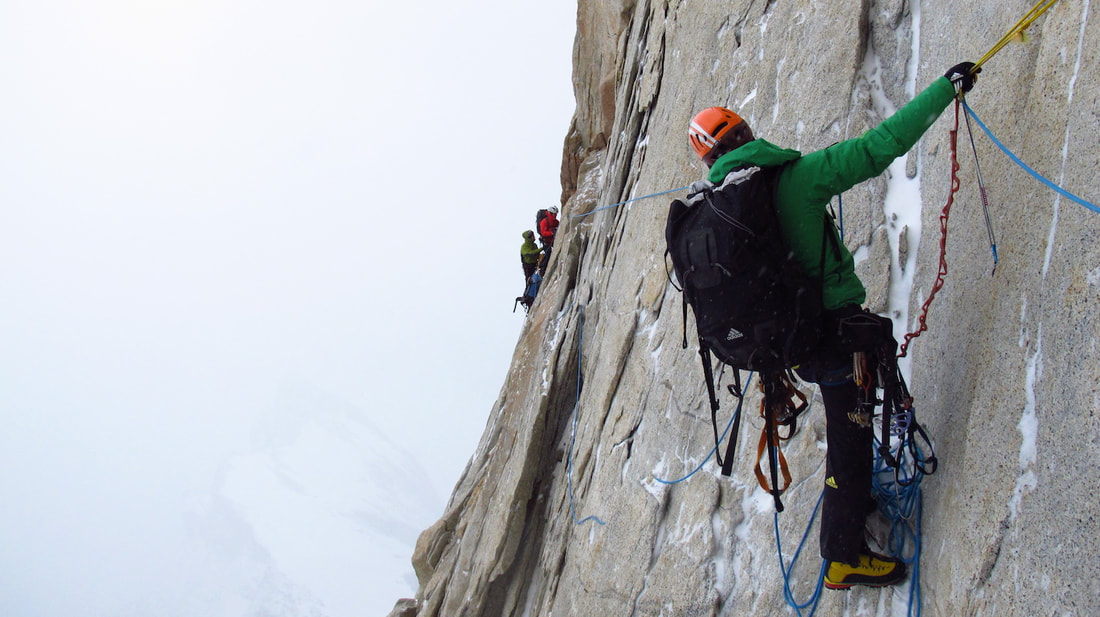
With Much Maier, Hansjörg Auer and Mario Walder high up La Silla Westface…. We got and unexpected big storm and we had to retreat. Anyway a summit is not always important to make the adventure to a great moment in life…. It is the friendship and how you handle scary moments in the team… Patagonia 2012 Photo Credit: Hansjörg Auer
PATAGONIA
My path to the mountain ranges of Patagonia was not a direct one. My bother, Alexander was already there in 1999. He had told me about his fascinations of this mountain world. But, at that time, those mountains were too low for me – I was attracted to peaks sitting at 7000m. Mountaineering in the Karakoram and Himalayas was for me.
Alexander and I had failed together on the Ogre in Pakistan 1999. Then, in 2000, Alexander had to cancel an expedition to Shivling, India due to illness. At this time, Alexander began shifting his focus back to rock climbing. For the time being he had had enough of the high mountains and argued, "I can do expedition mountaineering when I am old, but I can no longer climb hard."
That was a key moment in our rope team as brothers. I understood his reasoning and my romance to be part of the Huberbuam rope team was stronger than following the path of 7000m peaks. We shifted to Yosemite Valley, climbed a heaps. It was the wildest, most intense and most beautiful time.
We were part of an incredible international climbing community, the Stonemonkeys, there in Yosemite – where rebelliousness, freedom, and vertical adventure consumed us. Many of the “monkeys” had no real home and, depending on the season, they travelled from climbing area to climbing area. In the "winter" we migrated to the South American "summer", to Patagonia. Suddenly the Patagonian Torre Valley became the new Yosemite Valley.
If there is one place in the world where the expedition scene meets nearly every year, it is in front of the Torre and the Fitz, in El Chalten, Patagonia. You won't find that type of congregation anywhere else. In Pakistan, everything is scattered, everyone goes their own way. But the community we had in Camp 4 in Yosemite, you can now only find in El Chalten.
The social life in El Chalten is almost as important as the mountain. A Cerro Torre or Fitz Roy are the reasons why you take the endless journey to the other end of the world, but if the weather is too bad, which is typical for Patagonia, you still have a great time. Although very touristy, El Chalten is the most beautiful hippie village at the end of the world.
It is no longer what German mountaineer Reinhard Karl once said: "Mountaineering in Patagonia is like sitting in the fridge and burning banknotes." Today we are no longer sitting in an ice cave under the mountain and waiting for good weather, instead, everyone lives in the village and you go bouldering instead.
There are also some beautiful areas around Chalten for sport climbing (the weather in the village is usually much better than 10 km further back in the mountains.) And when it rains such that you can't do anything outside, you meet for a beer or a good bottle of Malbec (a great red wine). It’s the modern way to burn money, and philosophize about mountaineering, discuss the weather models, and make plans for the next fair weather window. Sometimes you end up leaving without a mountain, but maybe you’ve bagged a small summit, or a big adventure, or some new friends. In any case, Patagonia has is exciting, wildly romantic and beautiful!
|
|
LATOK I
How do I find my goals? I don't really need to look for them because so many ideas still live in my head. I am crazy about magic lines on an apparently impossible wall. My fascination is to make the impossible possible through ability, mental strength, and with the team dynamic. (This is why I burn inside for expeditions!)
Each alpinist cooks his own soup in relation to his goals and favourite areas. Although I have many goals, I don't talk too much about them. Every alpinist has their own “secret recipes” of plans.
My love of expeditions began with the Latok II in 1997. It was further stoked by first ascent of the Shiviling north tower in India with Iwan Wolf in 2000 and our award of the Poilet DÓr (the Golden Ice Axe award). Next came the momentuous ascent of 7285-meter-high Ogre III in Pakistan in 2001 with Iwan Wolf and Urs Stöcker. The Ogre III was one of the most difficult mountains in the world at the time because the number of failed expeditions. Then, 14 years later, after experiencing many other adventurous expeditions, I came back to my origins, back to the Latok group in Pakistan, seeking it’s highest peak, Latok I (7,108m).
There were four of us on the way to Choktio for Latok I: Mario Walder, Dani Arnold, my brother, and me. Our goal was the impenetrable north side of the mountain. Similar to the Ogre’s failed histories, there were now over 40 failed expeditions on the north side of Latok I. There has been a lot of talk about the Latok I North Face, some have called this challenge, "The Holy Grail of Mountaineering.”
The wall became best known because of the story when in 1978 Jim Donini, Michal Kennedy, George and Jeff Lowe entered the North Ridge in pure alpine style. After 16 days they set the highest point on this wall. But, at 7000 meters, just 145 meters from the summit, they turned around because Jeff Lowe’s health did not allow them to reach the top together. After 26 days, they were all back in the base camp in good health. They survived together! Their adventure was dubbed “the most remarkable failure in alpine history” and their story, along with the first ascent story of the Ogre with Chris Bonington and Dough Scott, are certainly some of the wildest in alpine history.
The North Face of Latok I had everything my mountaineer's heart could desire. The perfect line and the apparent impossibility. It is absolutely amazing.
Thirty-eight years after his attempted ascent of Latok I, 70-year-old Jim Donini stood in front of Latok on the Choktoi Glacier and, with a shaky voice and wet eyes, said, "I've been alpine climbing half a century, I've been in many mountain ranges over all seven continents, and to me, where I am now, it is the mountain-cathedral with all the Latoks and the Ogres. There is no more beautiful place on the planet, there are no more beautiful and difficult mountains to climb, this is it, right here ...”
I can agree with Jim Donini's words. Those mountains are second to none, even if they do not scratch the magical 8000 meters and hardly have any status among the general public. For this, these mountains give you the loneliness. And, for a summit success they still demand your all - everything still has to fit together, not only the weather and your skills, but the courage to stand in front of an impossible wall and take the first step.
Once there on Lotok I, we quickly understood why no one had climbed the wall, or why so many failed on Northridge. Everything on the north side is long, steep and extremely dangerous. In the end, Latok I showed us the limits. We were very lucky to have survived an avalanche event. We did not summit.
How do I find my goals? I don't really need to look for them because so many ideas still live in my head. I am crazy about magic lines on an apparently impossible wall. My fascination is to make the impossible possible through ability, mental strength, and with the team dynamic. (This is why I burn inside for expeditions!)
Each alpinist cooks his own soup in relation to his goals and favourite areas. Although I have many goals, I don't talk too much about them. Every alpinist has their own “secret recipes” of plans.
My love of expeditions began with the Latok II in 1997. It was further stoked by first ascent of the Shiviling north tower in India with Iwan Wolf in 2000 and our award of the Poilet DÓr (the Golden Ice Axe award). Next came the momentuous ascent of 7285-meter-high Ogre III in Pakistan in 2001 with Iwan Wolf and Urs Stöcker. The Ogre III was one of the most difficult mountains in the world at the time because the number of failed expeditions. Then, 14 years later, after experiencing many other adventurous expeditions, I came back to my origins, back to the Latok group in Pakistan, seeking it’s highest peak, Latok I (7,108m).
There were four of us on the way to Choktio for Latok I: Mario Walder, Dani Arnold, my brother, and me. Our goal was the impenetrable north side of the mountain. Similar to the Ogre’s failed histories, there were now over 40 failed expeditions on the north side of Latok I. There has been a lot of talk about the Latok I North Face, some have called this challenge, "The Holy Grail of Mountaineering.”
The wall became best known because of the story when in 1978 Jim Donini, Michal Kennedy, George and Jeff Lowe entered the North Ridge in pure alpine style. After 16 days they set the highest point on this wall. But, at 7000 meters, just 145 meters from the summit, they turned around because Jeff Lowe’s health did not allow them to reach the top together. After 26 days, they were all back in the base camp in good health. They survived together! Their adventure was dubbed “the most remarkable failure in alpine history” and their story, along with the first ascent story of the Ogre with Chris Bonington and Dough Scott, are certainly some of the wildest in alpine history.
The North Face of Latok I had everything my mountaineer's heart could desire. The perfect line and the apparent impossibility. It is absolutely amazing.
Thirty-eight years after his attempted ascent of Latok I, 70-year-old Jim Donini stood in front of Latok on the Choktoi Glacier and, with a shaky voice and wet eyes, said, "I've been alpine climbing half a century, I've been in many mountain ranges over all seven continents, and to me, where I am now, it is the mountain-cathedral with all the Latoks and the Ogres. There is no more beautiful place on the planet, there are no more beautiful and difficult mountains to climb, this is it, right here ...”
I can agree with Jim Donini's words. Those mountains are second to none, even if they do not scratch the magical 8000 meters and hardly have any status among the general public. For this, these mountains give you the loneliness. And, for a summit success they still demand your all - everything still has to fit together, not only the weather and your skills, but the courage to stand in front of an impossible wall and take the first step.
Once there on Lotok I, we quickly understood why no one had climbed the wall, or why so many failed on Northridge. Everything on the north side is long, steep and extremely dangerous. In the end, Latok I showed us the limits. We were very lucky to have survived an avalanche event. We did not summit.
Cerro Kishtwar, Himalayas. First ascent of the new route "Har Har Mahadev."
BUILDING SUCCESS
In my early days of climbing, I was unable to “turn over and go back to sleep” when a climb could not be completed. I would drive home frustrated because I still had the urge to “do something” – to complete, to accomplish. Today, however, I have become much more relaxed and I can now fully experience the mountains from the beginning to wherever I end up. This is because the mountains provide relief from a busy life of appointments, lectures , and social media. In these moments, I only keep in touch with my family (via the Satellite phone) and my concentration turns to basic needs - good weather, good health, good conditions, and a good team.
In order to be successful on an expedition, many building blocks are required. But, perhaps the most important item of all is mental balance and strength. In the end there is no magic recipe for success, because every project has its own dynamic. For example, when we were on the Cerro Kishtwar, in the Himalayas, we thought we could easily do it in six days. On the third day we only completed a third of the wall. We realized we had completely underestimated the climb.
Although the weather was perfect, we decided to withdraw because we were running out of food. After a week we climbed back to the wall, but this time, the weather was poor and all the cracks were iced up. But, we did have more provisions and we had each other! We fought for every meter together and after seven days we, Stephan Siegrist, Julian Zanker and I, stood on the top of Cerro Kishtwar.
We could only do it because we made a brave decision at a crucial moment to stop. Then, with the resources we needed, climbed this route together as a team. From time to time, as a perfect community, you can solve a seemingly hopeless situation and, with a little luck, make the impossible possible.
IDOLS
When I learned in 2018 that the British climber, Tom Livingstone with the Slovenes Ales Cesen and Luka Strazar, had climbed Latok I over the north side, I was speechless. I thought they had done it – completed my passion. If you are deeply passionate about something, it is normal to have a little competition with others. Nobody is completely selfless, but no one wants to admit that. When I saw their clever line to the summit, traversing over to the west side ¾ of the way up, I was able to sleep peacefully again. I was relieved, as that was not my desired route. So it feels as though the beat of my heart is still unbroken.
As a mountaineer, an area that enchants you the most is your heart.
As little boys and budding climbers, Alexander and I had great idols like Kurt Albert and Wolfgang Güllich. I remember how we brothers stood in front of Wolfgang in Buoux and had a short chat with him. I stared at his biceps with my mouth half open I just thought: “Wow, this is really Wolfgang, the best climber of all time. What would I give... ”
Moments like these go with you, into your own climbing and mountaineering. When Alexander and I drove to the Nameless Tower in Pakistan (almost thirty years after meeting Wolfgang) to climb the Eternal Flame, it was not primarily about collecting the first ascent, but rather about exploring the history of our great role models.
Role models are often defined by the esteemed Piolet d'Or award. For some, that “Oscar of Mountaineering” drove the choice of expedition locations, perhaps making the award more important than the adventure for which it was awarded. During that time the Piolet d’Or lost some of its esteem – when people were given the award without consideration of the gear or destruction they left behind.
Today the Piolet d’Or is experiencing a renaissance because it is a prize for mountaineers and respect for the mountain – it once again is identifying idols. One of the award’s criterion is “Respect for the mountains that surround us, the beauty of movement, and the spirit in which people climb those mountains are also primary conditions for the awarding of the prize. We cannot in fact pass down to future generations summits mutilated in the name of a destructive climbing style without profoundly altering the spirit itself of this activity.”
There is also now a lifetime achievement award. Alpinists like Wojtek Kurtyka, Jeff Lowe, Chris Bonington, Dough Scott, Reinhold Messner, Walter Bonnatti or Kurt Diemberger have been honored. What a wonderful way to honor and celebrate mountaineering. The award now goes beyond recognition, and is more like a mountaineering meeting, a gathering of kindred spirits.
When I learned in 2018 that the British climber, Tom Livingstone with the Slovenes Ales Cesen and Luka Strazar, had climbed Latok I over the north side, I was speechless. I thought they had done it – completed my passion. If you are deeply passionate about something, it is normal to have a little competition with others. Nobody is completely selfless, but no one wants to admit that. When I saw their clever line to the summit, traversing over to the west side ¾ of the way up, I was able to sleep peacefully again. I was relieved, as that was not my desired route. So it feels as though the beat of my heart is still unbroken.
As a mountaineer, an area that enchants you the most is your heart.
As little boys and budding climbers, Alexander and I had great idols like Kurt Albert and Wolfgang Güllich. I remember how we brothers stood in front of Wolfgang in Buoux and had a short chat with him. I stared at his biceps with my mouth half open I just thought: “Wow, this is really Wolfgang, the best climber of all time. What would I give... ”
Moments like these go with you, into your own climbing and mountaineering. When Alexander and I drove to the Nameless Tower in Pakistan (almost thirty years after meeting Wolfgang) to climb the Eternal Flame, it was not primarily about collecting the first ascent, but rather about exploring the history of our great role models.
Role models are often defined by the esteemed Piolet d'Or award. For some, that “Oscar of Mountaineering” drove the choice of expedition locations, perhaps making the award more important than the adventure for which it was awarded. During that time the Piolet d’Or lost some of its esteem – when people were given the award without consideration of the gear or destruction they left behind.
Today the Piolet d’Or is experiencing a renaissance because it is a prize for mountaineers and respect for the mountain – it once again is identifying idols. One of the award’s criterion is “Respect for the mountains that surround us, the beauty of movement, and the spirit in which people climb those mountains are also primary conditions for the awarding of the prize. We cannot in fact pass down to future generations summits mutilated in the name of a destructive climbing style without profoundly altering the spirit itself of this activity.”
There is also now a lifetime achievement award. Alpinists like Wojtek Kurtyka, Jeff Lowe, Chris Bonington, Dough Scott, Reinhold Messner, Walter Bonnatti or Kurt Diemberger have been honored. What a wonderful way to honor and celebrate mountaineering. The award now goes beyond recognition, and is more like a mountaineering meeting, a gathering of kindred spirits.
CHANGING LANDSCAPES
Alpinism is changing in many ways. Closer to my home in Europe, the opinion still exists that peak alpinism is only on the international level (Asia or Patagonia or Alaska), but not in the Alps. Top alpinism can be lived everywhere, including in the European Alps! There is a challenge in every wall and its up to the individual to find it.
The mountain landscape has changed in several ways in recent years, starting with our climate! When we were on the Latok II in 1997, it was still frosty in July at 6000m, even in the best weather. As a result, it was reasonably safe on the mountain. Twenty-two years later, in 2019, the freezing level rose to above 6000 meters. This made all technically difficult mountains unpredictably dangerous from rock falls and avalanches. Glaciers have also reduced in size dramatically, underlining the trend of warming.
As a mountaineer, you are faced with a new challenge: Either you have to climb a lot more at night, or you have to be out and about in the colder season, with the risk of unstable weather.
But, there is also a positive change. In 1997 at Latok II we were completely on our own. We organized the entire expedition ourselves, hired porters and cooks, had no contact with the outside world for two months, the weather report was based solely on our observations from the Thommen altimeter (which supplied the air pressure and we compared it with the current weather conditions.)
Using these tools we had to learn the behaviour of the local weather. During a rescue, we were 90% on our own. Helicopter rescue was possible from the base camp, but this had to be notified first, which for Latok included a 50 km journey on foot to Askole and 170 km jaunt by jeep to Skardu. That is two full days. The material was also twice as heavy at the time.
Today, there are agencies that can perfectly plan your adventure, creating an all-round care-free package from the airport. Everything is organized and you can fully enjoy your experience all the way to the base camp. You can request a weather report every day via the satellite telephone and thus plan and structure your tour optimally.
In the event of a rescue, the Pakistani military is well trained to carry out air rescue operations up to 6500 meters. The equipment has refined so much over the years that the most difficult passages can be mastered much faster and more safely. My favorites are the light cams, ice screws, birdbeaks, and John Middendorf’s Portaledges!
But, keep in mind, too much security can hide the dangers that always lurk on a mountain. The Guidebook by Rolando Garibotti describes all climbing routes in such a tasty way, it’s easy to forget how exposed you really are. For example, on the Cerro Torre West Wall in Patagania it’s not the difficulty of running out of the last hook, but the fact that in the event of an injury you are completely on your own. This ignorance is the greatest danger!
Risk and danger can also be injected from the outside, for example from sponsors or media pressure. What counts on the mountain is not what is expected of you, only what is in front of you. Once in the mountains it is only you and your partners. At the moment the adventure begins, any strange expectation should be shed. There should be no other motivation but to be with what’s in front of you.
Mt. Asgard, located in Auyuittuq National Park, on the Cumberland Peninsula of Baffin Island, Nunavut, Canada
A DIFFICULT YEAR
I recently heard a saying: “The more often you take risks, the more likely it will end up not going well.” There is truth to this, but if I always stay at home, the risk of something happening is, of course, less. Despite the changing landscapes of alpinsim, if you are passionate about something, you have to breathe life into it. This is joy. If I reduced life to a single, most important, essence, it would be the word “happy.” Live your happy.
2019 was not a good year for me. First a good friend, Julian Zanker, died while climbing the north face of the Eiger. Then came the deaths of Jess Rosskelley, Hansjörg Auer and Davia Lama on Howse Peak, Canada. That was a real blow to the climbing scene.
The pain we all felt from these deaths, sought answers. There was a lot of discussion amongst climbers. Why did it happen? Was it avoidable? It seems that Julian was simply unlucky. We don’t know exactly what happened to him, a slip on crampons in easy terrain? Rock fall? We do know he fell 20m and instantly died. He was unlucky in a moment when you were so unknowingly lucky to be on the mountain.
With Jess, Hansjörg and David, we also don’t know what occurred. Was it a wrong decision on the mountain? Was it a cornice break? No matter what the answers would be, it is never good and there is always deep pain because death is irreversible.
Many questions in these events cannot really be answered ... and that lack of answers can even be used as a justification for what we do. We still leave for the expedition even though we are aware of the risk.
Mountaineers go to the mountains and the edges because we really feel that where we live. I speak for Hansjörg, for David, for Julian, and all climbing friends who are no longer with us today: We never went to the limit because we have no respect for life. We go to the limit because we feel that life is unique, we love it, and we recognize that life does not forgive compromises.
In addition to the strategy of living at the edges, there is also something else that helps us to make the right decision on the mountain: It is love - love for your climbing partners, love for ourselves, and love for our family. This love is always stronger and higher than any mountain. Whether I climb Latok I before the end of my days, it doesn't matter. My life will not be better with that mountain or without it!
Nevertheless, I am still a mountaineer and driven by goals and visions, and I cannot eliminate certain lines from my thoughts. I am already planning my next expedition to the Choktoi, Pakistan because I love making the impossible possible. But in the end the most important thing is that I can tell about climbing it is this – It is absolutely necessary to stay alive! Be safe out there.
Antarctica: Together with Alexander and Stephan Siegrist in Holtanna Westface, Antarctica, 6c A3… it was such a great and very cold adventure 2008. Photo Credits: Max Reichl- Timeline Production

